Fashion Designing Course
Fashion designing is an exciting and dynamic field that blends creativity, art, and technology. It encompasses the design of clothing and accessories, influenced by cultural trends, historical references, and personal expression. A fashion designing course equips aspiring designers with the skills, knowledge, and practical experience needed to thrive in this competitive industry.
Course Structure
Typically, a fashion designing course spans three to four years, leading to a diploma or degree in fashion design. The curriculum is designed to cover various aspects of fashion, ensuring that students develop a comprehensive understanding of the field. Key subjects often include:
-
Fashion Illustration: Students learn to sketch designs effectively, using both traditional and digital techniques. Mastering illustration is crucial for conveying design ideas to clients and manufacturers.
-
Textile Science: This subject covers the properties, production, and uses of various fabrics and materials. Understanding textiles helps designers make informed choices about their creations, from functionality to aesthetics.
-
Garment Construction: Students gain hands-on experience in sewing and constructing garments. This practical skill is essential for bringing design concepts to life.
-
Pattern Making: This involves creating templates for garments. Students learn both flat pattern drafting and draping techniques, which are vital for accurate fitting and design execution.
-
Fashion History and Theory: Understanding the evolution of fashion allows designers to draw inspiration from past trends and movements. This subject often includes studying influential designers and iconic fashion moments.
-
Fashion Marketing and Merchandising: Knowledge of marketing strategies and retail operations is crucial for successful fashion designers. This module prepares students to launch and promote their own brands effectively.
-
Sustainable Fashion: As the industry increasingly focuses on sustainability, this subject teaches students about eco-friendly practices and ethical design.
-
Computer-Aided Design (CAD): Proficiency in CAD software is essential for modern fashion designers. This module introduces students to industry-standard tools for designing and visualizing collections.
Practical Experience
In addition to theoretical learning, fashion designing courses often emphasize practical experience. Many programs include internships or collaborative projects with industry professionals. These opportunities allow students to apply their skills in real-world settings, build a professional network, and gain insights into the industry's workings.
Career Opportunities
Graduates of fashion designing courses can pursue various career paths within the fashion industry, including:
- Fashion Designer: Creating original clothing and accessory designs.
- Textile Designer: Developing fabric patterns and textiles.
- Fashion Merchandiser: Planning and promoting fashion products in retail settings.
- Costume Designer: Designing outfits for theater, film, and television.
- Fashion Stylist: Curating looks for photo shoots, advertisements, or individual clients.
Skills Developed
Throughout a fashion designing course, students cultivate essential skills, such as:
- Creativity and Innovation: Developing unique design concepts and solutions.
- Attention to Detail: Ensuring precision in garment construction and finishing.
- Time Management: Balancing multiple projects and meeting deadlines.
- Communication Skills: Effectively conveying ideas to clients, team members, and manufacturers.
Conclusion
A fashion designing course is an enriching journey for individuals passionate about fashion and creativity. With a blend of artistic expression, technical skills, and industry knowledge, students are prepared to embark on a rewarding career in the vibrant world of fashion. Whether aspiring to design their own collection or work behind the scenes in merchandising or styling, a solid foundation in fashion design is the key to success in this ever-evolving industry.
